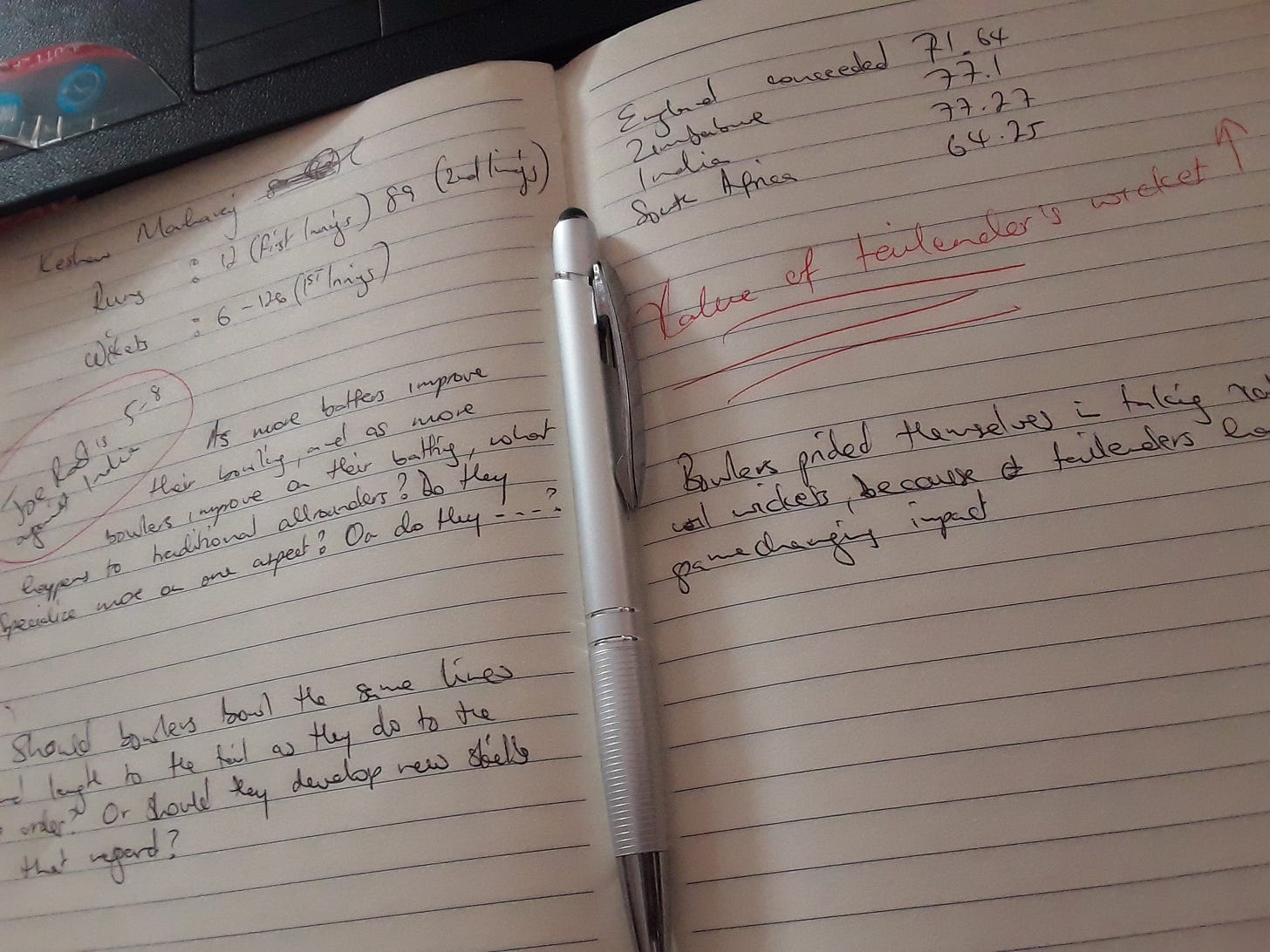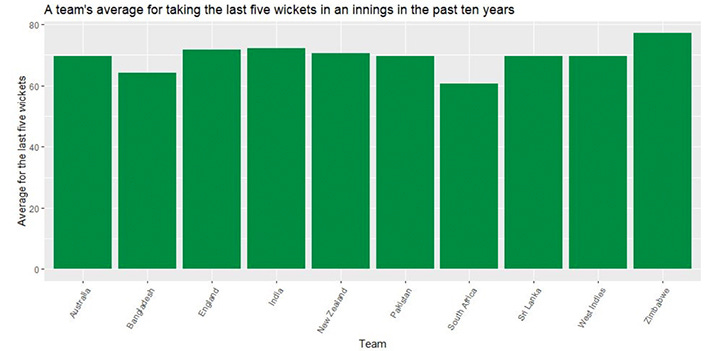Notes on The Rising Value of Tailenders' Wickets
For a long time, the wickets of tailenders have been considered to be of low value in terms of game-changing potential. Is it time to change the perception?
Wiping the tail is becoming an important and valuable skill as more teams struggle to do so efficiently…
Showing Up When It Matters The Most: The Psychology of Big Match Temperament
On More Time In The Middle And Reinvestment
PODCAST: Tim Wigmore: It All Boils Down To Competitive Advantage [The Idea-Sharing Project Ep. 03]
This week I share with you some of my notes that I took down as I watched Keshav Maharaj perform superbly in the last round of the 4-Day matches.
Keshav Maharaj recorded the best bowling in a match by a spinner at the Wanderers in FC Cricket and the 2nd best bowling overall at the Wanderers with his figures of 13 - 174. What makes Maharaj's figures even more interesting is that the Lions only managed one wicket through spin.
But, that is not the best part, for me. The best part was that Keshav Maharaj managed a quickfire 89 runs from 62 balls in the Dolphins' second innings. These runs, a total of 101 runs, tell the story of a bowler who has persistently worked on his batting. So much so that he almost looks like a genuine allrounder.
Maharaj, like many modern bowlers, including Kagiso Rabada, Stuart Broad and others, thinks he is quite handy with the bat. In fact, he is just as serious about his batting as Joe Root is serious about his bowling. They all take pride in it.


There was a time when batters in the bottom four did not score many runs. They routinely got dismissed with single-digit figures. And so, the standard procedure was for the proper batters to farm the strike in order to help the team get as many runs as possible. It was not uncommon for a tailender to last 15 overs, and yet only face between 18 and 24 deliveries, while their partner faced the other 66 or so deliveries.
The result? Tailender wickets had a low value. If it was chess, a tailender's wicket had the value of a pawn. They simply had no major game-changing impact on the total.
****
In the late 1990s to the early 2010s, the tail was "expected" to wag, and that was just about it. Wag for a few overs, before they were dismissed. But not anymore. Now, they are also expected to stick in and support the top order or make contributions of their own. Bowlers now pay attention to their batting.
As a result of this, the run contribution of the lower order has increased for most teams. In the 2000s the bottom four contributed an average of 15.51 runs. The average has gone up to around 20 runs.
The increase in runs by the tail has brought a different angle, teams are struggling more and more to dismiss the tail. In recent times, South Africa has struggled with dismissing the tail. Between 2010 and 2020, England has conceded an average of 70.16 runs to the tail. That is more than South Africa. See the graph for more. (graph courtesy of guerrillacricket.com)
Polishing off the tail is becoming even more important than it was before. Teams can no longer just wait for a tailender to make a mistake, or bowl indiscriminately to the tail.
*****
How will teams deal with this new reality? Keep using the same tactics with the hope that they will somehow work? Or will they evolve with the game and develop bowlers who can efficiently clean up the tail? Many bowlers tend to favour the short ball against the tail as an intimidation tactic, but if tailenders are getting more efficient with the bat, playing the pull shot better, means that the short ball concedes runs.
Kicker: the longer the tail stays in, the more frustrated fielding sides get and the more bad lines and length they bowl. Therefore, the more runs they concede. Yet, without a proper plan, you cannot get the tail out.
This Week’s Articles:
Without a doubt, all professional athletes have the temperament for competing against other extremely talented athletes. But not all of them possess the ability to not only perform at their best but to exceed what many thought possible when confronted by extreme pressure. - Showing Up When It Matters The Most
When athletes are going through a rough patch, do they need to go back to the basics, fight fire with fire or take a step back? - On More Time In The Middle and Reinvestment
PODCAST: Tim Wigmore: It All Boils Down To Competitive Advantage [The Idea-Sharing Project Ep. 03]
Article From The Archives:
Chemistry is the cumulative team attitude. It’s how teammates feel about each other, each other’s skill and their chances to succeed. It’s about how they handle adversity and loss. - A Case For Chemistry
If you enjoy the content here and on Chadwick Drive, there are a couple of ways you can show your appreciation.
You can Buy Me A Coffee. You can buy several coffees if you like (simply change the number of coffees to your preferred amount). All coffees you buy will be greatly appreciated.
Alternatively, please encourage anyone you think may be interested to subscribe to this newsletter, the blog or both.





